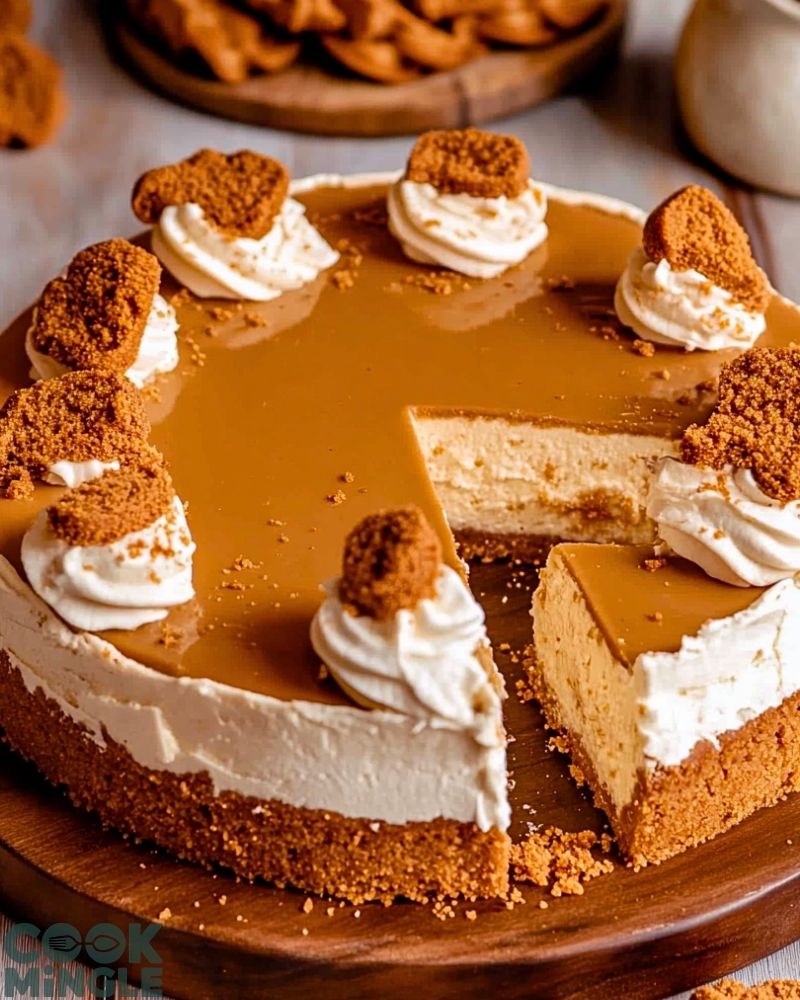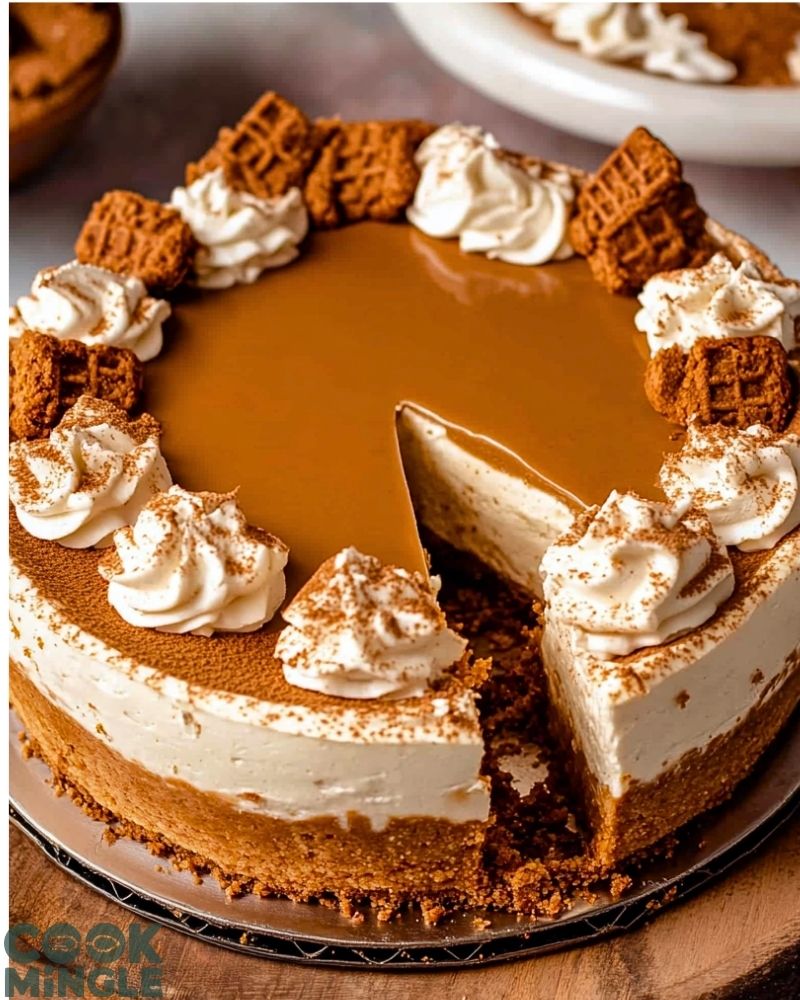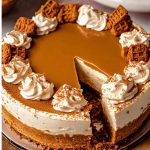There’s something undeniably magical about the rich, spiced sweetness of Biscoff cookies—and when you swirl that goodness into a creamy cheesecake? Absolute dessert heaven. I’ve always had a soft spot for Biscoff spread, so creating this cheesecake was a true passion project. From the crunchy cookie crust to the silky-smooth Biscoff-infused filling and the luscious caramel-like topping, every bite is pure indulgence.

The best part is how this Biscoff cheesecake manages to feel both nostalgic and luxurious at the same time. Whether you’re serving it at a special gathering or enjoying a quiet slice with a cup of coffee, it delivers that “wow” factor without being overly complicated to make. Let me show you why this recipe is going to become one of your go-to dessert showstoppers.
Why You’ll Love This Biscoff Cheesecake
- Unique Flavor: The spiced caramel notes of Biscoff cookies and spread give this cheesecake a flavor profile that’s unlike any traditional dessert.
- Crowd-Pleaser: It looks impressive, slices beautifully, and never fails to get rave reviews.
- No Water Bath Needed: Despite its rich, creamy texture, this recipe doesn’t require a fussy water bath to bake perfectly.
- Make-Ahead Friendly: It actually tastes even better the next day, making it ideal for prep ahead of time.
- Customizable Toppings: Want to drizzle chocolate or top it with more crushed cookies? Go for it.
What Kind of Biscoff Should I Use?
When it comes to making this cheesecake, the two main Biscoff products you’ll need are Biscoff cookies (also known as Lotus biscuits) and Biscoff cookie butter spread. The cookies are used for the crust and for decorative topping, while the spread is blended into the cheesecake filling and also poured over the top.
For the cookies, the classic Lotus Biscoff biscuits are perfect. They’re crunchy, flavorful, and crush easily for a buttery crust. For the spread, use the creamy version—it blends smoothly into the batter without any lumps. While the crunchy version of the spread exists, it can affect the texture of your filling and topping.
Options for Substitutions
- Cookies: If you can’t find Biscoff cookies, you can substitute them with graham crackers or speculoos cookies, though the flavor will slightly differ.
- Cookie Butter: No Biscoff spread? Use another brand of cookie butter or even peanut butter for a different twist (though it won’t have the signature spiced caramel taste).
- Cream Cheese: Regular full-fat cream cheese works best, but you can swap it with Neufchâtel for a slightly lighter version. Avoid fat-free varieties—they don’t hold up as well.
- Sour Cream: Greek yogurt is a good alternative if you’re out of sour cream. Just make sure it’s plain and unsweetened.
- Whipped Cream Topping: Feel free to use a dairy-free whipped topping if needed—coconut whipped cream adds a lovely complementary flavor.
Ingredients for This Biscoff Cheesecake
Each ingredient in this Biscoff cheesecake plays a key role in building its flavor and texture. Here’s a closer look at what you’ll need and why:
- Biscoff Cookies
These spiced, caramelized biscuits are crushed to form the buttery crust and used again as a garnish. They deliver the unmistakable flavor that defines this cheesecake. - Unsalted Butter
Melted and mixed with the crushed cookies, butter binds the crust and gives it a rich, golden finish after baking. - Cream Cheese
The heart of any cheesecake. Use full-fat, room-temperature cream cheese for a smooth, creamy filling that holds its shape beautifully. - Granulated Sugar
Sweetens the filling just enough to balance the tang of the cream cheese and enhance the cookie butter’s natural caramel tones. - Sour Cream
Adds a subtle tang and silky texture to the cheesecake, making it luscious and light without being too dense. - Biscoff Cookie Butter Spread
The star ingredient—blended into the batter for flavor and melted over the top for a glossy finish. It infuses the cheesecake with deep, spiced caramel flavor. - Vanilla Extract
Just a splash brings out the best in both the cream cheese and cookie butter, enhancing the overall taste. - Eggs
Help the cheesecake set and hold together while baking. Room-temperature eggs ensure even mixing and a smooth consistency. - Heavy Cream (for topping)
Whipped and piped around the edge, it adds lightness and contrast to the rich cheesecake filling. - Optional: Powdered Sugar (for whipped cream)
Adds sweetness and stability to the whipped cream topping, especially if you want defined swirls.

Step 1: Prepare the Crust
Start by preheating your oven to 325°F (163°C). Crush the Biscoff cookies into fine crumbs using a food processor or by placing them in a zip-top bag and crushing with a rolling pin. Combine the crumbs with melted unsalted butter until the texture resembles wet sand. Press the mixture evenly into the bottom of a 9-inch springform pan, making sure it’s compact and level. Bake the crust for 10 minutes, then set it aside to cool while you make the filling.
Step 2: Make the Cheesecake Filling
In a large mixing bowl, beat the cream cheese with an electric mixer on medium speed until it’s smooth and free of lumps. Add the granulated sugar and continue beating until well combined. Mix in the sour cream, vanilla extract, and Biscoff spread. The cookie butter should blend seamlessly with the cream cheese for a uniform, velvety texture.
Step 3: Add the Eggs
Add the eggs one at a time, mixing just until combined after each addition. Avoid overmixing once the eggs are in—the goal is to keep the batter airy but not whipped, which can cause cracks while baking.
Step 4: Bake the Cheesecake
Pour the filling into the cooled crust and gently smooth the top with a spatula. Tap the pan lightly on the counter to release any air bubbles. Bake for 50–60 minutes until the edges are set but the center still has a slight jiggle. Turn off the oven, crack the door, and let the cheesecake cool inside for 1 hour. This gradual cooling helps prevent surface cracks.
Step 5: Chill the Cheesecake
After it cools, refrigerate the cheesecake for at least 6 hours—or preferably overnight. Chilling allows it to firm up completely and intensifies the flavors.
Step 6: Add the Topping
Once chilled, spread a layer of gently melted Biscoff spread over the top of the cheesecake. Let it set for a few minutes in the fridge so it firms into a glossy glaze. Pipe whipped cream around the edges and garnish with whole or halved Biscoff cookies to finish.
How Long to Cook the Biscoff Cheesecake
The total baking time for the Biscoff cheesecake is 50 to 60 minutes at 325°F (163°C). You’ll know it’s done when the edges are set and the center has a subtle jiggle—it should look slightly underbaked in the middle, which is perfect. Avoid opening the oven door too often, as sudden temperature changes can lead to cracks.
After baking, let the cheesecake rest in the oven with the door cracked open for 1 hour. Then transfer it to the refrigerator to chill for at least 6 hours, or overnight for best results. This slow, steady cooling ensures the texture sets properly without overbaking.
Tips for Perfect Biscoff Cheesecake
- Use Room Temperature Ingredients
This is key for a smooth, lump-free filling. Let your cream cheese, eggs, and sour cream sit out for at least 30 minutes before mixing. - Don’t Overmix After Adding Eggs
Beating too much air into the batter at this stage can lead to cracking. Mix gently and just until combined. - Line Your Springform Pan
A circle of parchment paper on the bottom helps with easy release. Greasing the sides can also prevent sticking. - Water Bath Optional
This cheesecake doesn’t require a water bath, but if you’re nervous about cracking, you can place a tray of hot water on the lower rack of your oven to keep moisture high. - Cool Gradually
Sudden temperature changes cause cracks. Cooling in the oven and then chilling overnight gives the cheesecake a flawless finish. - Warm the Knife for Slicing
Dip a sharp knife in hot water and wipe it clean between slices for clean, picture-perfect cuts. - Use a Gentle Hand for Topping
Let the melted Biscoff spread cool slightly before pouring it on the chilled cake to avoid melting the surface. - Decorate Just Before Serving
Add whipped cream and cookies at the end to keep them crisp and fresh.
Watch Out for These Mistakes While Cooking
Even with a straightforward recipe like this one, a few common missteps can throw off your cheesecake game. Here’s what to avoid:
- Skipping the Room Temp Rule
Cold cream cheese or eggs won’t blend smoothly, which can lead to a lumpy batter and uneven texture. - Overbeating the Batter
Especially after the eggs go in, too much mixing adds air to the batter and often results in cracks during baking. - Using Low-Fat Ingredients
Cheesecake is one of those recipes where full-fat really matters. Low-fat cream cheese or sour cream can cause the cake to be runny or chalky. - Not Pre-Baking the Crust
Skipping this step means your crust could turn soggy instead of staying crisp and buttery. - Taking It Out Too Early
Don’t panic at the jiggle—it should wobble slightly in the center. Pulling it out too soon will leave you with an unset center. - Skipping Chill Time
This is crucial for both flavor and texture. A cheesecake that hasn’t chilled long enough will taste more like pudding than cake. - Pouring Hot Topping on the Cold Cake
Melted Biscoff spread should cool slightly before going on top, or it may melt into the cheesecake surface instead of forming a glossy layer. - Rushing the Cooling Process
Cheesecake is sensitive—don’t move it straight from oven to fridge. The gradual cool-down avoids splitting or collapsing.
What to Serve With Biscoff Cheesecake?
Pairing this cheesecake with the right drinks or sides can turn it from just dessert into a full-on experience. Here are some ideas to elevate your serving game:
Coffee or Espresso
The roasted bitterness balances the sweet and spiced notes of the Biscoff beautifully.
Fresh Berries
Raspberries, strawberries, or blueberries cut through the richness and add a pop of color and brightness.
Vanilla Bean Ice Cream
If you want to go full indulgence, a scoop of ice cream beside each slice is divine.
Salted Caramel Drizzle
Layer even more decadence with a hint of salt—it amplifies the caramel tones in the cookie butter.
Dessert Wine or Port
For an elegant touch, a small glass of sweet wine can complement the rich creaminess.
Chocolate Shavings
Sprinkle some dark chocolate curls on top for contrast and a bit of luxury.
Apple Slices with Cinnamon
Sautéed apple slices bring warmth and texture—perfect for autumn vibes.
Mini Biscoff Cupcakes (as a side treat)
If you’re entertaining, these mini versions can be served alongside or as a sampler for guests.
Storage Instructions
Biscoff cheesecake stores beautifully, making it perfect for preparing ahead or enjoying over several days. Here’s how to keep it fresh and delicious:
- In the Fridge
Store the cheesecake covered in the refrigerator for up to 5 days. Use plastic wrap or an airtight container to prevent it from drying out or absorbing odors. - In the Freezer
This cheesecake freezes surprisingly well. Wrap individual slices or the whole cake tightly in plastic wrap, then again in foil, and freeze for up to 2 months. When ready to serve, thaw in the fridge overnight. Avoid freezing with the whipped cream topping—add that fresh after thawing. - Make Ahead Tip
You can prepare the cheesecake (minus the topping) 1–2 days in advance. Add the melted Biscoff topping and whipped cream decorations just before serving for the freshest presentation.
Estimated Nutrition
Please note, the following values are approximate and can vary based on portion size and any ingredient substitutions:
- Serving Size: 1 slice (1/12 of cheesecake)
- Calories: ~480
- Total Fat: 33g
- Saturated Fat: 18g
- Cholesterol: 120mg
- Sodium: 250mg
- Total Carbohydrates: 40g
- Sugars: 27g
- Protein: 6g
- Fiber: 0.5g
This is a rich dessert, no doubt—but every bite is worth it!
Frequently Asked Questions
What size pan should I use for this cheesecake?
A standard 9-inch springform pan works best for this recipe. If using a smaller or larger size, you’ll need to adjust the baking time accordingly.
Can I make this recipe without a springform pan?
While a springform pan is ideal, you can use a deep cake pan lined with parchment paper. Just know it may be harder to remove cleanly.
How can I prevent cracks in my cheesecake?
Avoid overmixing the batter (especially once eggs are added), don’t overbake, and cool the cheesecake gradually in the oven. Cracks don’t affect the taste—but they can be covered beautifully with topping!
Can I use crunchy Biscoff spread?
Technically yes, but creamy Biscoff spread gives the cheesecake a smoother texture. Crunchy versions may create an uneven filling.
Is it okay to use low-fat cream cheese?
Low-fat cream cheese can make the texture grainy and less stable. For best results, stick with full-fat cream cheese.
Can I make this cheesecake gluten-free?
Yes! Use gluten-free speculoos-style cookies or a gluten-free graham cracker alternative for the crust. Make sure all other ingredients are certified gluten-free.
How do I get clean slices when serving?
Use a sharp knife dipped in hot water, and wipe the blade clean between cuts. This ensures smooth, bakery-style slices every time.
Can I add chocolate to this cheesecake?
Absolutely! A drizzle of chocolate ganache or even chocolate chips folded into the filling can be a delicious twist.
Conclusion
Biscoff cheesecake is that kind of dessert that instantly impresses—whether it’s a holiday table centerpiece, a birthday treat, or just a weekend baking win. Its silky texture, caramel-spiced flavor, and elegant topping make it unforgettable, yet it’s surprisingly simple to pull off with the right steps. I’ve made this recipe more times than I can count, and it never disappoints.
Once you’ve tasted it, you’ll know: this isn’t just another cheesecake—it’s the cheesecake. Now that we’ve covered everything, let’s move on to the printable version so you can save or share it easily.

Biscoff Cheesecake Recipe
- Total Time: 7 hours 10 minutes
- Yield: 12 slices
Description
Get ready to fall in love with this indulgent and creamy Biscoff Cheesecake! A buttery Biscoff cookie crust sets the stage for a velvety filling swirled with rich, spiced cookie butter. Topped with a glossy layer of melted Biscoff spread and crowned with whipped cream and cookie crumbles, this showstopping dessert is a guaranteed hit. Whether you’re looking for a quick dessert idea, an easy recipe for a dinner party, or unique food ideas to elevate your baking game, this Biscoff cheesecake is your answer. It’s the perfect blend of nostalgic flavor and modern flair—a sweet treat that’s sure to impress.
Ingredients
- 2 cups Biscoff cookie crumbs (about 30 cookies)
- 1/2 cup unsalted butter, melted
- 3 (8 oz) blocks cream cheese, room temperature
- 3/4 cup granulated sugar
- 1/2 cup sour cream, room temperature
- 2/3 cup Biscoff cookie butter spread
- 1 tsp vanilla extract
- 3 large eggs, room temperature
- 1/2 cup Biscoff cookie butter (for topping)
- 1/2 cup heavy whipping cream (optional for garnish)
- 2 tbsp powdered sugar (optional for whipped topping)
- Extra Biscoff cookies for garnish
Instructions
- Preheat oven to 325°F (163°C). Line the bottom of a 9-inch springform pan with parchment paper.
- Combine Biscoff crumbs and melted butter. Press into the pan to form the crust. Bake for 10 minutes, then cool.
- In a large bowl, beat cream cheese until smooth. Add sugar and beat until incorporated.
- Mix in sour cream, vanilla extract, and cookie butter spread until smooth.
- Add eggs one at a time, mixing just until combined.
- Pour filling over crust and smooth the top. Tap pan to remove air bubbles.
- Bake for 50–60 minutes, until edges are set and center slightly jiggles.
- Cool in oven with door slightly open for 1 hour. Chill in fridge at least 6 hours or overnight.
- Melt additional cookie butter and spread over chilled cheesecake.
- Whip cream with powdered sugar (if using) and pipe around edges. Garnish with extra Biscoff cookies.
- Prep Time: 20 minutes
- Chill Time: 6 hours
- Cook Time: 50 minutes

